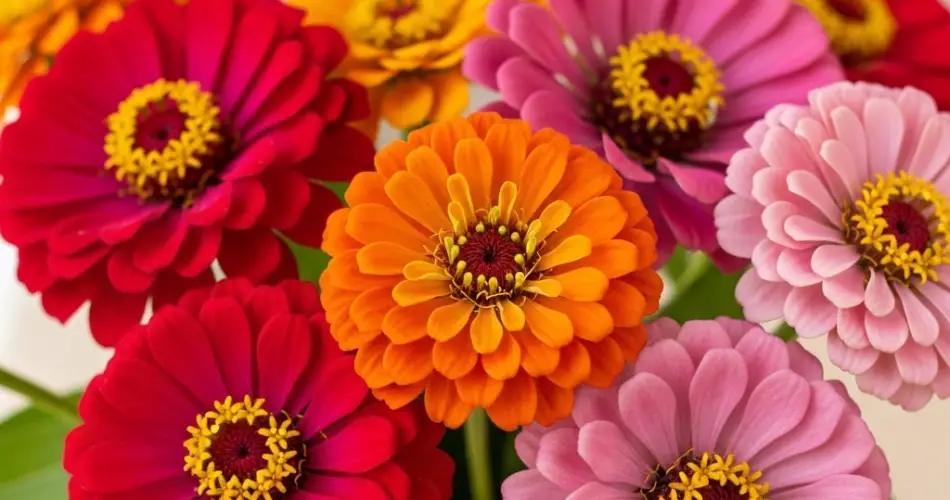Zinnias are beloved for their bold colors, long-lasting blooms, and ability to attract pollinators like butterflies and bees. These low-maintenance flowers are a favorite in both flower beds and container gardens. However, like all plants, zinnias can fall victim to various pests. The good news is that you can keep your zinnias thriving without resorting to synthetic pesticides. With natural pest control methods, you can manage unwanted insects while preserving the health of your garden and the beneficial organisms that support it.
Here’s a comprehensive guide to naturally protecting your zinnias from common pests.
Common Pests That Affect Zinnias
Before choosing a control method, it’s helpful to understand which pests are most likely to target your zinnias:
1. Aphids
Small, soft-bodied insects that cluster on new growth. They suck plant sap, causing distorted leaves and stunted growth. They also secrete honeydew, which leads to sooty mold.
2. Spider Mites
Tiny, often invisible to the naked eye, spider mites feed on the underside of leaves, causing stippling and webbing. Infestations are common in hot, dry conditions.
3. Japanese Beetles
These metallic green beetles feed on zinnia leaves and flowers, often skeletonizing the foliage.
4. Leafhoppers
These fast-moving insects suck sap and can transmit diseases such as aster yellows, which can distort growth and flowers.
5. Caterpillars
Various caterpillars feed on zinnia leaves, chewing large holes and weakening the plant.
Natural Pest Control Methods
To maintain healthy zinnias while keeping your garden eco-friendly, try the following natural pest control strategies:
1. Handpicking
For larger pests like beetles and caterpillars, the simplest solution is to remove them by hand. Early morning is the best time, as insects are less active. Drop pests into a bucket of soapy water to dispose of them safely.
2. Encourage Beneficial Insects
Nature offers its own pest control army. Attract beneficial predators that feed on harmful insects:
-
Ladybugs and lacewings eat aphids and other soft-bodied pests.
-
Parasitic wasps target caterpillars and beetles.
-
Spiders and ground beetles are generalist predators.
To attract these helpful creatures, plant companion flowers like dill, fennel, yarrow, or cosmos near your zinnias.
3. Neem Oil Spray
Neem oil is a natural pesticide derived from the neem tree. It disrupts the life cycle of many pests by affecting their hormones and feeding habits. It’s effective against aphids, spider mites, and caterpillars.
How to Use:
-
Mix neem oil with water and a small amount of dish soap (as per product instructions).
-
Spray in the early morning or late evening to avoid harming pollinators.
-
Reapply every 7–10 days or after rainfall.
4. Insecticidal Soap
Insecticidal soaps are made from potassium salts of fatty acids and are safe for most beneficial insects when applied correctly. They’re particularly useful against aphids, whiteflies, and spider mites.
How to Apply:
-
Spray directly on infested leaves, covering both upper and lower surfaces.
-
Repeat as needed, but avoid spraying during the heat of the day to prevent leaf burn.
5. Companion Planting
Grow pest-repelling plants alongside your zinnias to create a balanced, pest-resistant environment. Good companion plants include:
-
Basil and oregano, which repel aphids and beetles.
-
Marigolds, which deter nematodes and leafhoppers.
-
Lavender and thyme, which repel moths and other flying insects.
6. Maintain Garden Hygiene
Many pest problems start with poor garden practices. Keeping the area around your zinnias clean helps prevent infestations.
-
Remove weeds that harbor pests.
-
Clear dead or decaying plant material.
-
Rotate flower placements each season to discourage recurring pest populations.
7. Water Properly
Overwatering or underwatering can stress your zinnias and make them more vulnerable to pests. Use drip irrigation or water at the base of the plant to keep leaves dry and reduce fungal risks, which can attract insects.
8. Mulching
Organic mulch helps regulate soil moisture and temperature while suppressing weeds. It can also deter soil-borne pests from accessing the plant stems. Apply a thin layer of straw, shredded bark, or compost around the base of your zinnias.
Watch for Disease Transmission
Some pests, like leafhoppers and aphids, not only cause direct damage but also spread diseases. If you notice signs of viral or bacterial infections—such as yellowing, curling leaves, or twisted flower heads—remove and destroy the affected plants to prevent the spread.
Final Thoughts
Keeping your zinnias healthy and free from pests doesn’t mean you have to rely on chemical treatments. By using natural pest control methods—such as encouraging beneficial insects, applying neem oil, and practicing good garden hygiene—you can enjoy vibrant blooms while supporting a thriving garden ecosystem. With regular monitoring and thoughtful care, your zinnias will remain a bold and colorful feature in your garden all season long.



